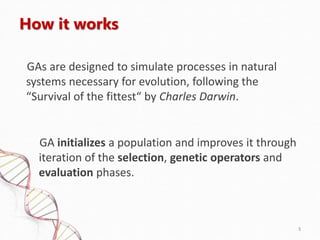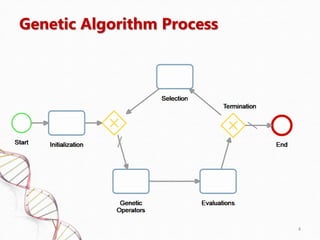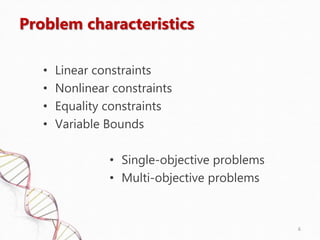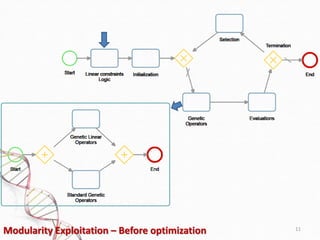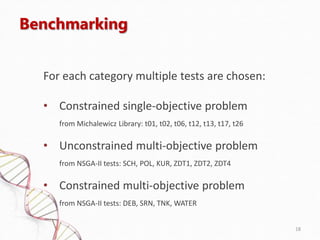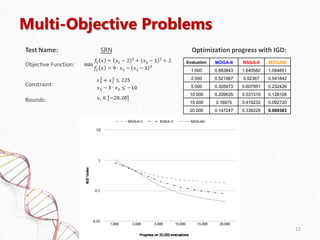A Modular Genetic Algorithm Specialized for Linear Constraints
- 1. A Modular Genetic Algorithm Specialized for Linear Constraints Stefano Costanzo, Lorenzo Castelli, Alessandro Turco
- 2. Genetic Algorithms Genetic Algorithms are popular stochastic optimization methods inspired by the evolutionist theory on the origin of species and natural selection. GAs are particularly suitable for solving complex single and multi-objective problems and finding reasonably good trade-off solutions. 2
- 3. How it works GAs are designed to simulate processes in natural systems necessary for evolution, following the ŌĆ£Survival of the fittestŌĆ£ by Charles Darwin. GA initializes a population and improves it through iteration of the selection, genetic operators and evaluation phases. 3
- 5. Target Effectively tackle problems with specific characteristics and maintain at least the performance of state-of-the- art Genetic Algorithms. 5
- 6. Problem characteristics ŌĆó Linear constraints ŌĆó Nonlinear constraints ŌĆó Equality constraints ŌĆó Variable Bounds ŌĆó Single-objective problems ŌĆó Multi-objective problems 6
- 7. Modularity ŌĆó Each phase is well defined and independent ŌĆó New valid phases are simple to design ŌĆó Multiple alternatives can co-exist ŌĆó Wide variety of specialized GA phases in literature 7
- 9. Modularity Exploitation - Selection 9
- 10. Modularity Exploitation ŌĆō Genetic Operators 10
- 11. Modularity Exploitation ŌĆō Before optimization 11
- 12. Before Optimization - Linear Constraints Logic 12
- 14. MOGASI Multi-Objective Genetic Algorithm for Structured Inputs
- 15. MOGASI - Complete Initialization Phase 15
- 16. MOGASI - Main Loop 16
- 17. Benchmarking Three different categories of tests are performed: ŌĆó Constrained single-objective problem ŌĆó Unconstrained multi-objective problem ŌĆó Constrainted multi-objective problem 17
- 18. Benchmarking For each category multiple tests are chosen: ŌĆó Constrained single-objective problem from Michalewicz Library: t01, t02, t06, t12, t13, t17, t26 ŌĆó Unconstrained multi-objective problem from NSGA-II tests: SCH, POL, KUR, ZDT1, ZDT2, ZDT4 ŌĆó Constrained multi-objective problem from NSGA-II tests: DEB, SRN, TNK, WATER 18
- 19. Competitors ŌĆō State of the Art GAs ŌĆó GENOCOP III ŌĆó Non-dominated Sorting Genetic Algorithm, NSGA-II ŌĆó Multi-Objective Genetic Algorithm, MOGA-II ’üČZ. Michalewicz and G. Nazhiyath - Genocop III: co-evolutionary algorithm for numerical optimization problems with nonlinear constraints ’üČK. Deb ŌĆō A fast and elitist multiobjective genetic algorithm: NSGA-II ’üČC. Poloni, V. Pediroda - GA coupled with computationally expensive simulations: tools to improve efficiency 19
- 20. Single Objective Problems Test name t13 Objective Function: Constraint: Bounds: Average Optimal Solution Percentage Deviation GENOCOP 0.1422 % MOGASI 0.0000 % NSGA-II 43.704 % MOGA-II 40.527 % GENOCOP 24.9644 MOGASI 25.0000 NSGA-II 14.0738 MOGA-II 14.8680 10,00 12,00 14,00 16,00 18,00 20,00 22,00 24,00 26,00 Genocop MOGASI NSGA-II MOGA-II 20
- 21. Medal Table ŌĆō Single-Objective Problems 21 1st 2nd 3rd 4th
- 22. Multi-Objective Problems Test Name: SRN Optimization progress with IGD: Objective Function: Constraint: Bounds: Evaluation MOGA-II NSGA-II MOGASI 1 000 0.883843 1.640582 1.094851 2 000 0.521967 0.92367 0.541842 5 000 0.305973 0.607951 0.232426 10 000 0.209635 0.531319 0.128108 15 000 0.16975 0.419232 0.092720 20 000 0.147247 0.338228 0.069383 22
- 23. Medal Table - Multi-Objective Problems 23 1st 2nd 3rd
- 24. Conclusions ŌĆó Problem meta-type defined by characteristics ŌĆó Exploited specific characteristics knowledge ŌĆó Kept standard GAs performance ŌĆó Good results in Benchmarks ŌĆó Easy case study expansion 24
- 25. Thank you for your attention



